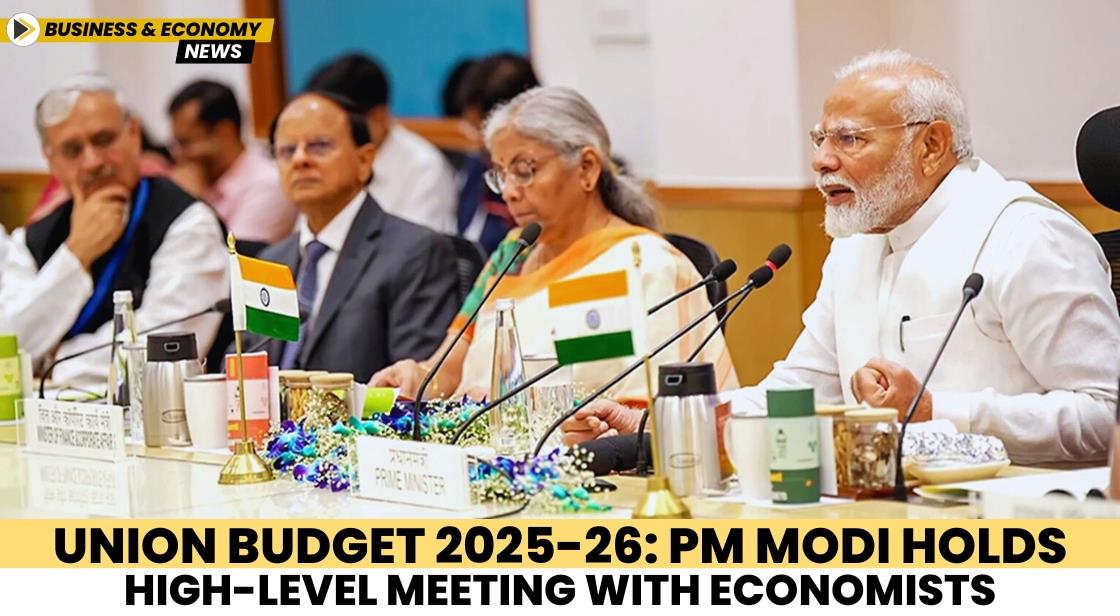Union Budget 2025-26: PM Modi Holds High-Level Meeting with Economists

News Synopsis
Prime Minister Narendra Modi convened a high-level brainstorming session with leading economists and sectoral experts on Monday, aiming to gather insightful recommendations and strategies for the Union Budget 2025-26.
This critical meeting was graced by the presence of Finance Minister Nirmala Sitharaman, Niti Aayog Vice Chairman Suman Bery, Niti Aayog CEO BVR Subrahmanyam, Chief Economic Advisor Anantha Nageswaran, and renowned economists, including Surjit Bhalla and DK Joshi.
Scheduled for presentation in Parliament on February 1, 2025, the forthcoming Budget is expected to be a blueprint for accelerating India's economic trajectory. The government’s continued emphasis on infrastructure development and social welfare schemes signifies its focus on boosting economic growth, creating jobs, and improving living standards.
Focus Areas for Union Budget 2025-26
Government Priorities
The Union Budget is expected to emphasize:
-
Infrastructure Investments: Continued focus on large-scale projects to enhance connectivity, create employment, and spur economic activity.
-
Social Welfare Programs: Initiatives such as free foodgrain distribution and housing support for economically weaker sections (EWS) in both urban and rural areas.
Inflation Control Measures
Recent data shows a decline in inflation, primarily driven by slowing food prices. This has provided the Reserve Bank of India (RBI) with room to implement monetary easing measures. In a significant move, the RBI reduced the Cash Reserve Ratio (CRR) for banks from 4.5% to 4%. This marks the first CRR cut since March 2020, injecting a substantial ₹1.16 lakh crore into the banking system, thereby improving liquidity.
India’s Economic Outlook
Sustained Economic Growth
India continues to maintain its position as the fastest-growing major economy globally. The government remains committed to policies that drive growth while ensuring fiscal prudence.
Robust Tax Collections
Higher tax collections have bolstered the government’s fiscal health.
-
Net Direct Tax Collections: Between April 1 and November 10, corporate and personal income tax revenues rose by 15.4%, totaling ₹12.1 lakh crore, according to the Central Board of Direct Taxes (CBDT).
-
GST Collections: Growing Goods and Services Tax (GST) revenues further strengthen the government’s financial standing.
Fiscal Deficit Reduction
For the April-October period, the fiscal deficit stood at 46.5% of the full-year target, reflecting strong financial management. The government aims to reduce the fiscal deficit to 4.9% of GDP for the current financial year, compared to 5.6% in the previous year.
Fiscal Consolidation Benefits
A controlled fiscal deficit minimizes borrowing needs, ensuring sufficient liquidity in the banking system. This not only supports corporate investments but also fuels economic expansion while maintaining stable inflation rates.
Broader Implications of Budget 2025-26
The Union Budget 2025-26 is expected to set the stage for long-term economic growth, ensuring a balance between fiscal discipline and developmental priorities. Key focus areas likely include:
-
Accelerating infrastructure projects to enhance competitiveness.
-
Expanding welfare measures to uplift marginalized sections of society.
-
Strengthening India's position in the global economic landscape.
Conclusion
The Union Budget 2025-26 is poised to be a landmark moment in India's economic journey, reflecting a fine balance between fiscal prudence and growth-oriented policies. Prime Minister Narendra Modi’s proactive engagement with economists and experts underscores the government's commitment to crafting a budget that not only addresses immediate economic challenges but also lays the foundation for sustainable, long-term growth.
The meeting highlights the government’s focus on several crucial areas, including boosting infrastructure investments, addressing inflationary pressures, and implementing social welfare programs that uplift the economically weaker sections. The recent reduction in the Cash Reserve Ratio (CRR) by the Reserve Bank of India is a testament to the alignment between fiscal and monetary policy, aimed at enhancing liquidity and supporting economic expansion.
India’s robust tax collections, particularly the 15.4% rise in net direct tax revenues, signify a healthy fiscal environment, further strengthened by the government’s adherence to its fiscal deficit reduction targets. The emphasis on fiscal consolidation is vital not only to ensure financial stability but also to maintain investor confidence and create a conducive environment for corporate investments.
This Budget will also be pivotal in shaping India's response to global economic uncertainties, leveraging its position as one of the fastest-growing major economies. By prioritizing infrastructure development, the government aims to boost connectivity and employment opportunities while fostering competitiveness on the global stage. Social welfare initiatives, such as free foodgrain distribution and housing for economically weaker sections, reflect the government's inclusive growth strategy, ensuring that the benefits of economic progress reach every citizen.
You May Like









